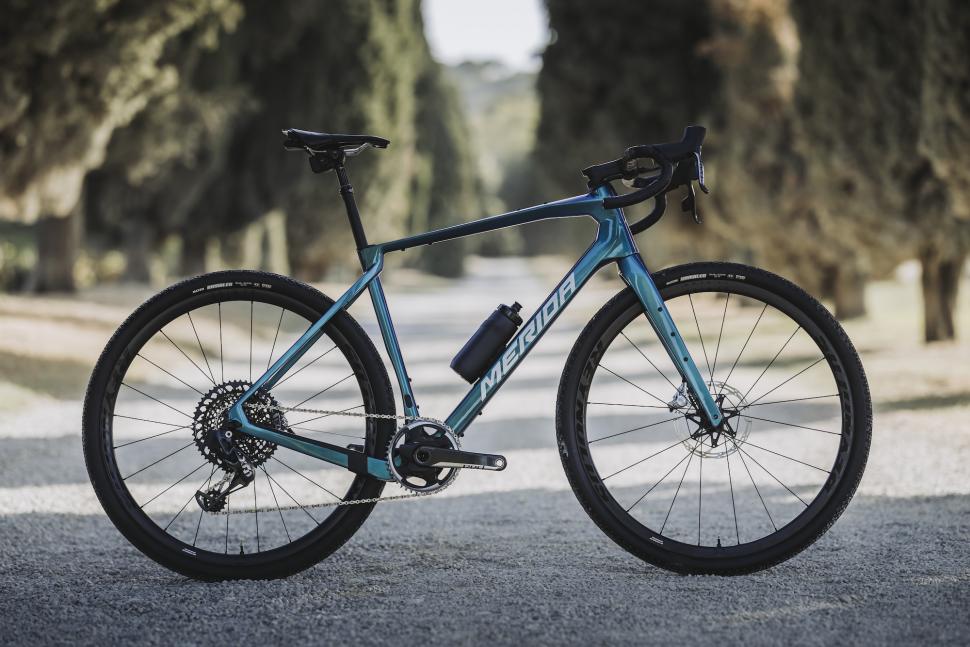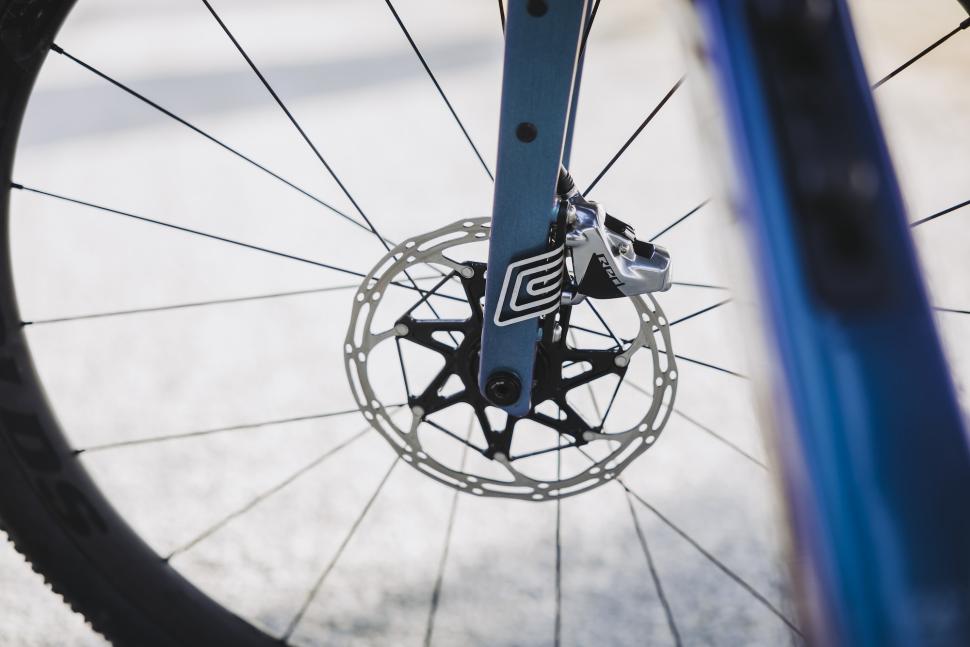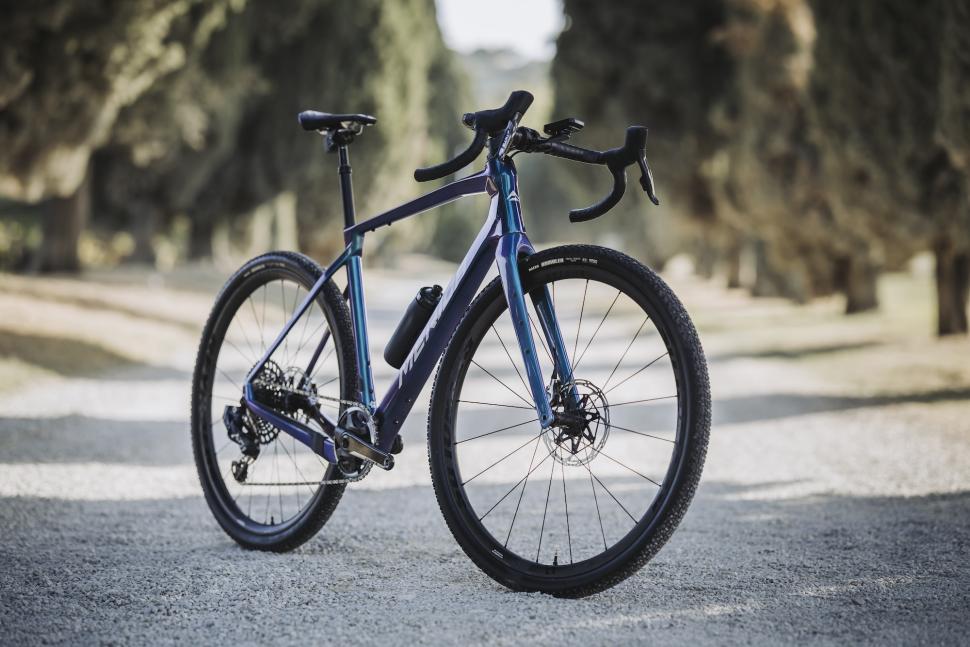- News
- Reviews
- Bikes
- Components
- Bar tape & grips
- Bottom brackets
- Brake & gear cables
- Brake & STI levers
- Brake pads & spares
- Brakes
- Cassettes & freewheels
- Chains
- Chainsets & chainrings
- Derailleurs - front
- Derailleurs - rear
- Forks
- Gear levers & shifters
- Groupsets
- Handlebars & extensions
- Headsets
- Hubs
- Inner tubes
- Pedals
- Quick releases & skewers
- Saddles
- Seatposts
- Stems
- Wheels
- Tyres
- Tubeless valves
- Accessories
- Accessories - misc
- Computer mounts
- Bags
- Bar ends
- Bike bags & cases
- Bottle cages
- Bottles
- Cameras
- Car racks
- Child seats
- Computers
- Glasses
- GPS units
- Helmets
- Lights - front
- Lights - rear
- Lights - sets
- Locks
- Mirrors
- Mudguards
- Racks
- Pumps & CO2 inflators
- Puncture kits
- Reflectives
- Smart watches
- Stands and racks
- Trailers
- Clothing
- Health, fitness and nutrition
- Tools and workshop
- Miscellaneous
- Buyers Guides
- Features
- Forum
- Recommends
- Podcast
TECH NEWS
 2023 Merida Silex - 1.jpeg
2023 Merida Silex - 1.jpegMerida launches all-new Silex - a world-championship-winning gravel bike
Despite being criticised for its looks, the first-generation Merida Silex was an impressive bike – for its time. The gravel space, however, is in a state of constant flux and the contemporary gravel bike formula has rendered many bikes - the Silex included - pretty much obsolete. This forced Merida to go back to the drawing board with the aim of improving its handling, all-round comfort, visual cues and off-road ability, and it seems to be bang on the money. After all, Bahrain Victorious rider Matej Mohoric, secured the 2023 UCI Gravel World Championship aboard the all-new Silex. Let’s take a closer look at the second-generation Silex or you can read our Merida Silex 10k first ride impressions on off.road.cc.
A new era
While the new Silex bears a striking similarity to the bike it replaces, there are subtle changes that have made a big difference to the way the bike looks and performs. The biggest difference is the shortened headtube which has now made upgrading to an aftermarket suspension fork a viable possibility.
The geometry has also been tweaked culminating in a shorter stack and room for bigger tyres; up to 45mm (42mm with fenders). Look closely and you’ll see the dropped chainstays near the bottom bracket which allows for both 1x and 2x drivetrain compatibility.
The head angle has also been slackened by 1.5 degrees to 69.5 degrees, aiding in more control and confidence when things get gnarly. Despite the relaxed front end, the bike still responds eagerly to pedal inputs and feels as quick on the flats as it does on climbs and descents – Merida has really got the balance right here. The Merida Silex is available in five sizes: XS, S, M, L and XL, with an XS measuring 55cm in top tube length. Crank arm sizes differ across the range with XS/S, M and L/XL using 170mm, 172.5mm and 175mm, respectively.
You’ll also notice the cleaner aesthetic and lack of excessive hoses and cable faff at the front end. Much of this comes compliments of the Wire Port integrated cable routing as seen on the Scultura and Scultura Endurance. The frame is compatible with internally routed dropper seatposts and also utilises a top-tube-integrated seatpost clamp and Fidlock base mount (the latter on CF models only) for a cleaner aesthetic.
Unlike Merida’s road bike range, there’s only one carbon-fibre layup available across all four models. A medium frameset tips the scales at 1,220g, 680g lighter than the alloy version (both the CF and alloy bike utilise a 540g carbon fork). A full bike in medium guise, weighs just over 9kg without pedals, which is impressive given the bike’s rowdy nature and bigger tyres. But the new Silex is not just about out-and-out performance and subsequently comes outfitted with a host of mounting bosses on the frame and fork for panniers, bags and rear carrier racks, the latter is available on aluminium frames only.
An interesting addition and something that no doubt helps instil in the rider a heightened level of confidence and control are the 180mm rotors fitted front/rear. While Merida claims this move was included to cater for the added weight of luggage and bike bags, it’s had a positive effect on its technical proficiency, too.
Merida Silex - Specification and model range
The all-new Merida Silex range comprises seven models: four carbon-fibre models and three aluminium options. Carbon models include the Silex 10k, 8000, 7000 and 4000 while the alloy Silex comes in 700, 400 and 200 derivatives. There’s a lot to offer – both in terms of price points and spec levels.
The range is spearheaded by the Silex 10k which gets a SRAM Red AXS/X01 mullet groupset – 42T, 10-52T – complete with a Quarq power meter. Everything from the Reynolds Blacklabel G700 Pro wheels to Easton EC70 AX handlebars are carbon fibre items. It also gets a RockShox Reverb AXS dropper post, a gravel-specific Prologo Scratch M5 AGX saddle and Maxxis Rambler 45c tyres.
Following the 10k is the Silex 8000. Details on this model are not yet clear but we assume its release will dovetail with the imminent launch of the Shimano GRX 12-speed Di2 groupset.
Next up is the Silex 7000 which substitutes all the carbon-fibre goodies of the 10k for lightweight aluminium components. The groupset is Shimano's new GRX RX820 which adds a 12th cassette sprocket. It gets a 42T upfront mated with an 11-51T cassette. The wheels are Easton EA70 AX and are also shod in Maxxis Rambler 45c rubber. There’s no dropper, instead, the bike gets a carbon-fibre Merida Expert solid post.
The Silex 4000 gets the same tyres and seatpost as the 7000 but ditches a 1x arrangement in favour of a Shimano GRX600 2x groupset for added range. As such the gearing is pegged at 46-30T, 11-36T. It also employs Merida-branded Expert Sl II wheels.
The aluminium Silex models are impressively specced and follow a similar specification convention as the carbon-fibre models. The Silex 700 is practically identical to the 7000 with the only differences coming in the form of the rotors – the 700 gets Shimano RT64 180/160mm front/rear as opposed to RT64 180mm all round.
One down is the Silex 400. It follows the 4000’s build quite closely sharing the same Merida Expert Sl II wheels, handlebar, saddle, tyres and Shimano GRX600 2x groupset. The only difference is the seatpost which favours alloy over carbon fibre and the 180/160mm rotor arrangement.
The entry-level model in the range is the Merida Silex 200. It gets a nine-speed Shimano Sora groupset, complete with 48-32T, 11-32T gearing assembly. The components are nothing flashy – Merida-branded stock – but are hardy enough to endure the rigours of off-road trails. The only component it shares with its stablemates is the Maxxis Rambler 45c tyres.
Merida Silex - pricing and availability
Merida has historically nailed things when it comes to value, often usurping many of its rivals as a result. The new Silex isn’t any different – in fact, the spread is impressive with build options designed to appeal to a wider audience. Bar the Merida 8000 which is yet to be released, all bikes are available immediately for purchase.
Merida Silex 10K: £8,750 / € 10,500
Merida Silex 8000: £5,250 / € 6,300
Merida Silex 7000: £3,000 / € 3,600
Merida Silex 4000: £2,250 / € 2,700
Merida Silex 700: £2,350 / € 2,820
Merida Silex 400: £1,650 / € 1,980
Merida Silex 200: £1,275 / €1,500
Aaron is the editor of off-road.cc. He completed his BA honours at the University of Cape Town before embarking on a career in journalism. As the former tech editor of Cyclingnews and Bike Perfect, digital editor of Bicycling magazine and associate editor of TopCar, he's travelled the world writing about bikes and anything with wheels for the past 17 years. A competitive racer and Stravaholic, he’s twice ridden the Cape Epic, raced nearly every mountain bike stage race in South Africa and completed the Haute Route Alps. He's also a national-level time triallist and eSports racer, too - having captained South Africa at both the 2022 and 2023 UCI Cycling eSports World Championships.
Latest Comments
- pockstone 31 min 35 sec ago
At the heart of great comedy lies truth.
- brooksby 33 min 38 sec ago
"I'm so sorry, I seem to have knocked that mirror. … I'm sorry, I seem to have done it again. And again."...
- Cugel 43 min 37 sec ago
The "more cycling infrastructure" lobby is fixated on their supposed "solution" to the dangers of bad driving, despite an overwhelming amount of...
- Car Delenda Est 1 hour 24 min ago
If it rests on intent then the lock is fine if it's on your own property, you can't really argue the cyclist was eagerly waiting for their bike to...
- brooksby 1 hour 44 min ago
I read that 'article' earlier on....
- David9694 2 hours 46 min ago
Notwithstanding its collapsing circulation, I still get it quoted to me as a source of news and information in my local Comments section. If I...
- hutchdaddy 3 hours 19 min ago
It's clearly a shit car, you won't get your cycle in the back of it and it won't have a CD player.
- essexian 4 hours 37 min ago
Before I had even said this persons home address, my wife said upon hearing the story: "He's from Loggerheads isn't he...."
- Rekrab 13 hours 40 min ago
MORE LANES, MORE LANES!!!!
- Simon E 13 hours 46 min ago
The numbers don't tell anything like the whole story....








































































Add new comment
15 comments
Fenders?! Is it a boat?
Aaron's a South African, maybe they use the American English word for mudguards?
you can read our Merida Silex 10k first ride impressions on off.road.cc.
Can I though? All I ever get is this:
off.road.cc can't currently handle this request.
HTTP ERROR 500
Whoever took those photographs what were you thinking?
The images of the whole bike are ok but not the detail shots. You have to search around to find anything in focus! It's not "arty", it's just wrong.
Just because you have a lens capable of f1.2 or whatever it is doesn't mean you have to! Try f/4 at least please.
Oh, let him play with his new-old Helios 40. It keeps him out of trouble.
Yeah, you're right. I was grumpy but I've had some food now and feel better. Sorry Mr. Photographer you go for it....
You forget - these days, photography is "art" and no longer just a rather easy craft in which the machine (and the software) does all the work. "Art" has to be far away from having any kind of utility. These days its only decoration, with information sent off elsewhere about its business!
"Lookit me creamy bokeh and Adobe preset colour profiles. No one could frame this splodge of summick or other and choose the moment to
copycreate it but me, the arteest! That'll be £10,000 plis."What are you going on about? Are you getting enough sleep?
Being ole scrote, I gets lots of sleep, inclusive of periods during which exotic dreams occur; and also weird ones. But just before I nod-orf there can be periods of mind-wander concerning this & that which one comes across in the culture-spheres that are everywhere about today.
But I'll put it simply: many modern-day photographers have become hubristic and desirous of high status, which they believe can be acquired by pretending that pressing a button on an automated machine whilst pointing it at something makes "art".
In fact, such procedures are no different from other trivial tasks such as cooking or driving. (One needs some competance; anyone can easily acquire it, although many just pretend they've done so). Of course, many cooks and drivers also big-up their minor craft skills, for the same reason. "Lookit how exceptional I am at this!" Ha ha.
In all these cases, the product is often neither art nor craft but rather some sort of smudge covered in very poor PR blather. Poor photographs, poor dinners and very poor driving (but with lots of engine noise and skid marks).
But I suppose this too will go wingin' over your bonce and off into the clouds.
I think one can reliably add photography to the vast range of subjects that you pompously pontificate on despite knowing absolutely fuck all about it.
Perhaps they're just not quite up with the latest trends?
Wot!? Nothing!!?
Of course, there's not that much to know .... although I have been trying to know it since the dark room at skool and via several other photo-related pursuits. I do confess to an ignorance concerning photographic art, though, as I've never seen any.
But I imagine you yourself are expert at producing smudgy coloured photees that are "edgy" and "revelationary", eh? Do you print and hang them on your walls for visitors to gasp at in admiration?
.
At least the photographer has ignored the current trend of photographing black bikes on a black background with the lowest possible power flash.
At least this guy has used ... light.
Struggling to see why that single in-focus bottle mount screw was so important though.
Art, that is. It suggests so much about the bicycle, doncha think, despite the obscuring of the details; and the details pictured being rather peripheral. One is stimulated to picture the nature of the bike by having to imagine what most of it must be like, rather than seeing it clearly in the pics.
Art! A Mark One will probably be framing prints of it even now.